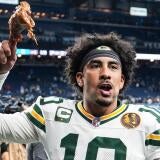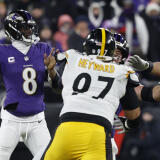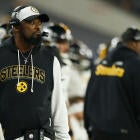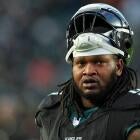Titans exhaust all options in efforts to slow the Patriots' 2-TE offense
The Titans will face one of the league's most explosive offenses in Sunday's opener against the Patriots. New England's innovative two-tight end set enabled its offense to put 30 points or more in seven of its last eight regular-season games last season. The Patriots won all eight.
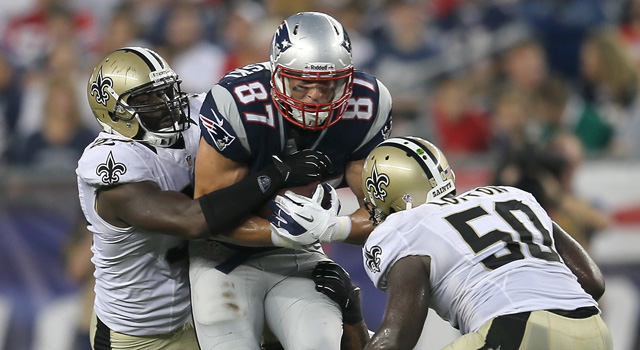 |
| In the red zone, Patriots TE Rob Gronkowski is virtually unstoppable. (Getty Images) |
The New England Patriots’ myriad of options in their explosive spread offense can bewilder the brightest defensive minds and leave coordinators with a string of sleepless nights heading into game day.
Patriots coach Bill Belichick’s latest innovation has transformed an already potent offense into one that put up 30 points or more seven times during an eight-game winning streak to end the 2011 regular season. Belichick’s use of tight ends Rob Gronkowski and Aaron Hernandez in tandem has enabled two-tight end sets to become fashionable throughout the league. Entering the season, at least seven others -- the Tennessee Titans, Steelers, Texans, Colts, Lions, Vikings and Cardinals -- are expected to use the set as an integral part of their offense.
When asked on Thursday how he plans on containing the Patriots in the formation, Titans defensive coordinator Jerry Gray provided a facetious response.
“Give the ball 50 times to Chris Johnson,” Gray said.
The tight ends are particularly lethal when used on the same side and on routes breaking into the middle of the field. In 2011, Gronkowski and Hernandez hauled in 20 of 23 passes headed in their direction on in-routes in two-tight end sets, according to ProFootballFocus.com. Another wrinkle used by Tom Brady is to target Hernandez when he’s lined up at H-back.
“It tends to make you show your hand when you have Hernandez in the backfield,” Gray said. “He’s going to isolate on a linebacker. If you put a DB in there, they know he’s isolated on the defensive backs. It helps their quarterback know if it’s man or zone.”
Titans linebacker Akeem Ayers knew of Gronkowski’s firepower before he emerged as one of the top tight ends in the NFL. When both starred in the Pac-10, Ayers’ UCLA defense was forced to use a nickel package to defend Gronkowski in Arizona’s spread. Gronkowski often found himself in a mismatch against the Bruins’ safeties.
In the red zone, Gronkowski is virtually unstoppable. In 2011, he had receptions on 19 of his 27 targets inside the 20-yard line, according to footballoutsiders.com. The 6-foot-6, 265-pound tight end also causes fits when running a rub or a pick on a linebacker before heading towards the corner of the end zone. The pick allows one of the Patriots underneath receivers to open up across the middle.
When heading downfield, depending on the coverage presented, Gronkowski can also put stress on a defender by running an option route. If a linebacker is playing to Gronkowski’s inside, he has the option of heading in the opposite direction, Ayers said.
“You have to play downfield technique and keep your hands on him before the five yards (rule expires),” Ayers said. “After that, you just have to play good defense and depend on your help.”
Gronkowski often runs the option routes when the Patriots use an empty backfield with three wide receivers and the aforementioned two tight ends. Interestingly enough, the Titans experimented with the same set in training camp after the selection of tight end Taylor Thompson in April’s NFL Draft.
“It’s something we’ve done a lot in practice too, so our defense has seen those things,” Titans coach Mike Munchak said. “Jerry’s done a good job of knowing what personnel we’re going to put on the field to match it. That’s part of the chess match of the game.”
The Titans can counter by using a dime set with six defensive backs, with the option of playing three safeties at once. Both the Giants and Bills employed three-safety packages in wins over New England last season. Last September, Buffalo safties Jairus Byrd, George Wilson and Da’Norris Searcy help spur a 21-point comeback in the 34-31 win. Gronkowski still finished with seven catches for 109 yards and two touchdowns, and Wes Welker had 16 catches for 217 yards and two scores.
Welker is known for accumulating receptions on underneath crossing routes and pivot routes. The ninth-year wideout tied for a league-high 21 catches on crossing routes last season, ProFootballFocus found. If a defensive back anticipates a slant or an inside breaking route from Welker, the receiver has a keen ability to pivot to the outside. Safety Jordan Babineaux said Welker runs the pivot route as well as any receiver in the league.
“If you’re overplaying one side or another he’s just going to break away from you,” Babineaux said.
The challenge will become easier for the Titans' secondary if their front four can effectively pressure Brady. The Patriots allowed 10 sacks in the preseason and will likely start a pair of inexperienced linemen in second-year left tackle Nate Solder and fourth-year center Ryan Wendell. Solder (6-8, 320) has been criticized for being too upright and rigid at times in the preseason. Titans defensive end Kamerion Wimbley, meanwhile, is regarded for his ability to dip under tackles while rushing around the edge. Wimbley could use it to his advantage.
“A lot of that depends on how the game is going and their blocking schemes,” Wimbley said. “When you watch him on film, he’s a giant out there. I’m looking forward to the challenge.”
This week, Babineaux and his teammates have focused on studying how the Patriots’ AFC East rivals have countered the Patriots’ unique looks in recent games.
“The only way to defend it is to see how other teams have diffused their attack,” Babineaux said. “That’s really the best thing we can do for ourselves right now.”
For more up-to-the-minute news and analysis on the Tennessee Titans, follow Matt Rybaltowski @CBSSportsNFLTEN.


